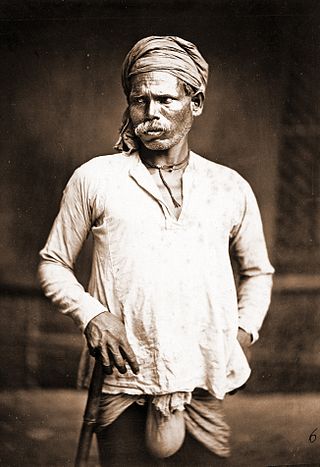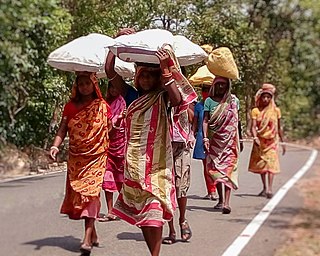Related Research Articles

Bihar is a state in Eastern India. It is the third largest state by population, the 12th largest by area, and the 14th largest by GDP in 2021. Bihar borders Uttar Pradesh to its west, Nepal to the north, the northern part of West Bengal to the east, and Jharkhand to the south. Bihar is split by the river Ganges, which flows from west to east.
The Other Backward Class (OBC) is a collective term used by the Government of India to classify castes that are educationally or socially backward. It is one of several official classifications of the population of India, along with general castes, Scheduled Castes and Scheduled Tribes (SCs and STs). The OBCs were found to comprise 52% of the country's population by the Mandal Commission report of 1980 and were determined to be 41% in 2006 when the National Sample Survey Organisation took place. There is substantial debate over the exact number of OBCs in India; it is generally estimated to be sizable, but many believe that it is higher than the figures quoted by either the Mandal Commission or the National Sample Survey.

The Dom, also known as Domra, Domba, Domaka, Dombara and Dombari, are castes, or groups, scattered across India. Dom were a caste of drummer. According to Tantra scriptures, the Dom were engaged in the occupations of singing and playing music. Historically, they were considered an untouchable caste called the Dalits and their traditional occupation was the disposal and cremation of dead bodies. They are in the list of Scheduled caste for Reservation in India in the Indian states of Uttar Pradesh, Bihar, Odisha, Andhra Pradesh, Jharkhand and West Bengal.
Mandal, also spelled Mondal, is an honorific title that was used for local chieftains in present-day Bangladesh, India and Nepal. The title was usually hereditary and so, in modern times, the term is a common surname for both males and females.
Bihari is a demonym given to the inhabitants of the Indian state of Bihar. Bihari people can be separated into three main Indo-Aryan ethnolinguistic groups, Bhojpuris, Maithils and Magadhis. They are also further divided into a variety of hereditary caste groups. In Bihar today, the Bihari identity is seen as secondary to caste/clan, linguistic and religious identity but nonetheless is a subset of the larger Indian identity. Biharis can be found throughout India, and in the neighbouring countries of Nepal, Pakistan and Bangladesh. During the Partition of India in 1947, many Bihari Muslims migrated to East Bengal. Bihari people are also well represented in the Muhajir people of Pakistan because of Partition.
Bhumihar, also locally called Bhuinhar and Babhan, is a Hindu caste mainly found in Bihar, the Purvanchal region of Uttar Pradesh, Jharkhand, the Bundelkhand region of Madhya Pradesh, and Nepal.
Bauri (Bengali:বাউরী) is a community of indigenous people primarily residing in Bengal, and considered as one of the Scheduled Castes of India. The Bauris belong to the Bhil tribe. They are usually involved in activities like farming. The Bauris of Purbo Tila Moulvibazar in Bangladesh are usually involved in medicinal practices. The prime festivals they celebrate are known as Mansa Puja, Durga Puja and Kali Puja.

Bhumij is a Munda ethnic group of India. They primarily live in the Indian states of West Bengal, Odisha, Assam and Jharkhand, mostly in the old Singhbhum district. Also in states like Bihar and Assam. There is also a sizeable population found in Bangladesh. Bhumijas speak the Bhumij language, an Austroasiatic language, and use Ol Onal script for writing.
The Kahars are a community of palanquin bearers originating from the Gangatic region.
The Bind are a caste found in Uttar Pradesh, Bihar, Madhya Pradesh, Assam, West Bengal, Chhattisgarh and Tripura. Bind are under the OBC category of the central list. Bind is one of the Nishad communities. In Uttar Pradesh, they are known by the Kewat sub-caste. In Bihar Bind comes under OBC.
Sadgop, also spelled as Sadgope, is a Bengali Hindu Yadav (Gopa) caste. Traditionally they are engaged in dairy-farming and cultivation. However, historically the Sadgop kings had ruled some parts of Rarh region in western Bengal such as Gopbhum, Narajole, Narayangarh and Balarampur. As of late nineteenth century they were one of the fourteen castes belonging to 'Nabasakh' group. As per census report of 1931, Sadgops predominantly lived in the Western Bengal districts of Midnapore, Burdwan and Birbhum.
Kandu or Kanu (Halwai) is a social group or caste that belongs to the Vaishya varna of the Hindu religion. The community is also referred to as Madheshia Vaishya. They are also identified with the term Bania of the Tirhut and Madhesi region, representing a community that has been historically associated with sweet-making, smaller trading activities, business, shop-keeping, grain -parching etc. in the eastern parts of India.

The Bhuiyan or Bhuiya or Bhouan are an indigenous community found in the Indian states of Bihar, Jharkhand, Madhya Pradesh, Odisha, Uttar Pradesh and West Bengal. They are not only geographically disparate but also have many cultural variations and subgroups.
Gopa or Gop or Gope is a synonym of the Yadav (Ahir) caste. It is generally used as a title by the Ahir caste in the states of Bihar, Jharkhand and West Bengal of East India and even in Terai region of Nepal.
The Koeri, also referred to as Kushwaha and more recently self-described as Maurya in several parts of northern India are an Indian non-elite caste, found largely in Bihar and Uttar Pradesh, whose traditional occupation was agriculture. According to Arvind Narayan Das they were horticulturist rather than agriculturists. They are also recorded as performing the work of Mahajan in credit market of rural parts of Bihar and Bengal in 1880s. Koeris have attempted Sanskritisation— as part of social resurgence. During the British rule in India, Koeris were described as "agriculturalists" along with Kurmis and other cultivating castes. They are described as a dominant caste in various opinions.

The Rajbanshi, also Rajbongshi and Koch-Rajbongshi, are peoples from Lower Assam, North Bengal, eastern Bihar, Terai region of eastern Nepal, Rangpur division of North Bangladesh and Bhutan who have in the past sought an association with the Koch dynasty. Today, Koch-Rajbanshi people speak Indo-Aryan languages, though in the past they might have spoken Tibeto-Burman languages. The community is categorised as OBC in Assam and Bihar, and SC in West Bengal. In Nepal they are considered part of the Plains Janjati. In Bangladesh the community is classified as Plains ethnic group under 'Barman'. They are the largest Scheduled Caste community of West Bengal.
Baishya Saha or Saha, though not considered Vaishya in the caste structure of Bengal, is a Bengali Hindu trading caste traditionally known to have the occupation of grocers, shopkeepers, dealers moneylenders, and farming.
Krishnaut or Kishnaut Ahir is a subclan of the Yadav (Ahir) caste found in Bihar, Jharkhand and Nepal. The term Krishnaut which to them denotes their descent from Lord Krishna.

Bagal is a cattle herding caste of East India. Bagal people are living in the state of West Bengal, Jharkhand and Odisha. They use Kudmali/ Manbhumi dialect of Bengali as mother tongue and use Bengali, Hindi and Odia language to communicate with the society.
Yadavs in Bihar refers to the people of Yadav community of the Indian state of Bihar. They are also known as Ahir, Gope, etc. The Yadavs form nearly 14.26 % of the state's population and are included in the Other Backward Class category in the Bihar state of India. Ahirs are among the land owning caste in the plains of Bihar.
References
- ↑ "List of caste wise population of Bihar". live Hindustan. Retrieved 2023-10-07.
- ↑ Sanyal, Hitesranjan (1981). Social Mobility in Bengal. Papyrus. p. 115.
- ↑ Guha, Ayan (2022-09-26). The Curious Trajectory of Caste in West Bengal Politics: Chronicling Continuity and Change. BRILL. pp. 128–129. ISBN 978-90-04-51456-0.
- ↑ "Bengal govt wary of implementing Mandal report,says OBC group". The Indian Express. 2010-01-10. Retrieved 2023-05-21.
- ↑ "Exclusive: Mamata's big caste gamble in TMC manifesto". India Today. Retrieved 2023-05-21.